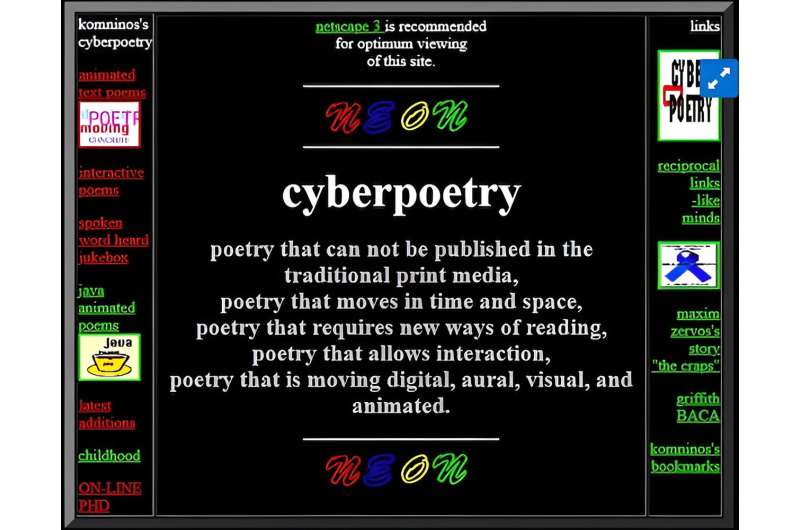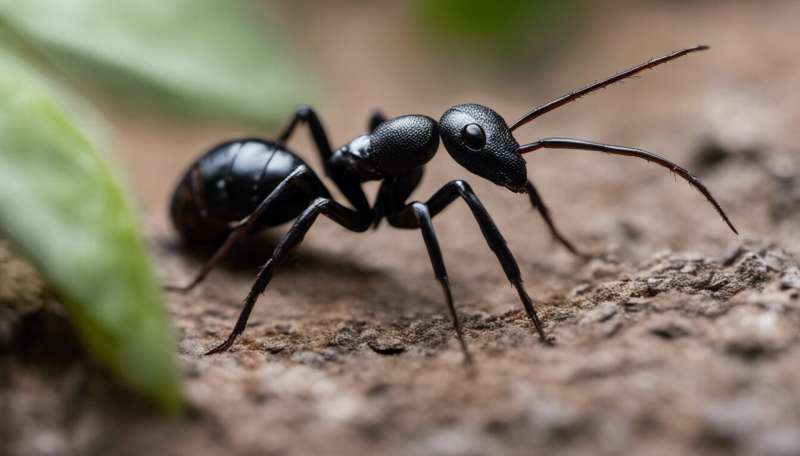30 years of the web down under: How Australians made the early internet their own

The internet is growing old. While the roots of the internet date back to the 1960s, the popular internet—the one that 99% of Australians now use—is a child of the 1990s.
In the space of a decade, the internet moved from a tool used by a handful of researchers to something most Australians used—to talk to friends and family, find out tomorrow's weather, follow a game, organize a protest, or read the news.
The popular internet grows up
This year marks 30 years since the release of Mosaic, the first browser that integrated text and graphics, helping to popularize the web: the global information network we know today.
Google is now 25, Wikipedia turned 21 last year, and Facebook will soon be 20. These anniversaries were marked with events, feature articles and birthday cakes.
But a local milestone passed with little fanfare: 30 years ago, the first Australian websites started to appear.
The web made the internet intelligible to people without specialist technical knowledge. Hyperlinks made it easy to navigate from page to page and site to site, while the underlying HTML code was relatively easy for newcomers to learn.
Australia gets connected
In late 1992, the first Australian web server was installed. The Bioinformatics Hypermedia Server was set up by David Green at the Australian National University in Canberra, who launched his LIFE website that October. LIFE later claimed to be "Australia's first information service on the World Wide Web."
Not that many Australians would have seen it at the time. In the early 1990s, the Australian internet was a university-led research network.
The Australian Academic and Research Network (AARNet) connected to the rest of the world in 1989, through a connection between the University of Hawaii and the University of Melbourne. Within a year, most Australian universities and many research facilities were connected.
The World Wide Web was invented by English computer scientist Tim Berners-Lee and launched in 1991. At the time, it was just one of many communication protocols for creating, sharing and accessing information.

Researchers connected to AARNet were experimenting with tools like Gopher and Internet Relay Chat alongside the web.
Even as a research network, the internet was deeply social. Robert Elz, one of the computer scientists who connected Australia to the internet in 1989, became well-known for his online commentaries on cricket matches. Science fiction fans set up mailing lists.
These uses hinted at what was to come, as everyday Australians got online.
The birth of the public internet
Throughout 1994, AARNet enabled private companies to buy network capacity and connect users outside research contexts. Ownership of the Australian internet was transferred to Telstra in 1995, as private consumers and small businesses began to move online.
With the release of web browsers like Mosaic and Netscape, and the increase in dial-up connections, the number of Australian websites grew rapidly.
At the start of 1995, there were a couple of hundred. When the Australian internet went public just six months later, they numbered in the thousands. By the end of the decade there were hundreds of thousands.
Everyday Australians get connected
As everyday Australians went online, students, activists, artists and fans began to create a diverse array of sites that took advantage of the web's possibilities.
The "cyberfeminist zine" geekgirl, created by Rosie X. Cross from her home in inner-west Sydney, combined a "Do It Yourself" punk ethos with the global distribution the web made possible. It was part of a diverse and flourishing feminist culture online.
Australia was home to the first fully online doctorate, Simon Pockley's 1995 Ph.D. thesis Flight of Ducks.
Art students presented poetry as animated gifs, labeling them "cyberpoetry." Aspiring science fiction writers published multimedia stories on the web.

The Australian internet goes mainstream
Political parties, government and media also moved online.
The Age Online was the first major newspaper website in Australia. Launched in February 1995, the site beat Australia's own national broadcaster by six months and the New York Times by a year.
Though The Age was first, ABC Online and ninemsn—linked to the Hotmail email service—were the most popular.
During the 1998 federal election, ABC Online saw over two million hits per week. Political parties, candidates and interest groups were quick to establish a web presence, kicking off the era of online political campaigning.
The web also became big business. By the end of the decade, Australia had its own internet entrepreneurs, including a future prime minister. Established media companies dominated web traffic.
"Internet fever" was sweeping Australian businesses, leading to an "internet stocks frenzy." The internet had gone mainstream and the "dot com bubble" was rapidly inflating.
Looking back on the decade the popular internet was born
The public, open, commercial internet is now a few decades old. Given current concerns about the state of the internet—from the power of large digital platforms to the proliferation of disinformation—it might be tempting to look at the 1990s as a "golden age" for the internet.
However, we must resist looking back with rose-colored glasses. What is needed is critical scrutiny of the conditions that underpinned internet use and attention to how a diversity of people incorporated technology in their lives and helped transformed it in the process. This will help us understand how we got the internet we have and how we might achieve the internet we want.
Understanding online history can be particularly difficult because many sites have long-since disappeared. However, archiving efforts like those of the Internet Archive and the National Library of Australia make it possible to look back and see how much things have changed, what concerns are familiar, and remember the everyday people who helped transform the internet from a niche academic network to a mass medium.
Provided by The Conversation
This article is republished from The Conversation under a Creative Commons license. Read the original article.![]()
Google bombards Australian search users as PR campaign intensifies









